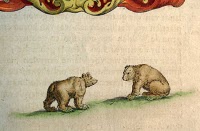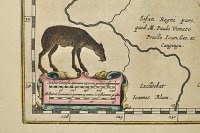Rachel Ingold, Senior Conservation Technician, shares her favorite conservation lab story. More videos from this series can be found on the Duke University Libraries You Tube channel.
All posts by Beth Doyle
Boxing the Devil

This little devil came to the lab from the University Archives for an enclosure. I put up a photo essay over on Flickr about how the box is constructed, and we posted about it over on Devil’s Tale.
What We Find In Books: Blaeu Bears and Deer

 Erin came across these illustrations in one of the Blaeu atlases that she has been working on. These are filled with lovely, hand painted images.
Erin came across these illustrations in one of the Blaeu atlases that she has been working on. These are filled with lovely, hand painted images.
We’ve been having a little fun trying to figure out what the bears were saying to each other, and whether this deer is from the lost herd of vampire deer from Transylvania. In all seriousness, look how it is ever so daintily standing on the frame whilst seemingly taking a nap. Very skillful (both the illustrator and the deer itself).
*Illustrations from: Willem Janszoon Blaeu, “Toonneel des aerdriicx, ofte nievwe atlas, dat is Beschryving van alle landen; nu nieulycx uytgegeven.” (E ff#91 dl.1 – 1649)
10 years, 10 people: Erin Hammeke
As part of our ten-year celebration we are highlighting everyone in the department. Erin Hammeke, Conservator for Special Collections has been with us for three years. Along with other conservators and staff from Special Collections, she selects items for conservation, designs treatment strategies and carries out those repairs. She works primarily on books from the Rare Book, Manuscript, and Special Collections Library. She documents each treatment using both photographic and written reports which we keep on file for future reference.
When asked about a favorite project, Erin replies:
 “Currently I am working on a volume of De Bry’s account of the New World, and this has been an extremely fun and challenging treatment that has involved paper repair, resewing the text, and rebinding in full calf leather. I am also wrapping up treatment of the Blaeu Atlases, six large Dutch atlases that were printed in the mid-1600s and hand painted with an inspired and vibrant color palette.
“Currently I am working on a volume of De Bry’s account of the New World, and this has been an extremely fun and challenging treatment that has involved paper repair, resewing the text, and rebinding in full calf leather. I am also wrapping up treatment of the Blaeu Atlases, six large Dutch atlases that were printed in the mid-1600s and hand painted with an inspired and vibrant color palette.
Over the past three years that I have spent at Duke, my main focus has been on the conservation of the Jantz Collection of German Baroque materials and German Americana. I love working with this collection because it seems to have everything – both in terms of content (there are materials that pertain to history,
travel, the occult, women’s writings, and more) and in terms of different binding styles and materials. For the most part, I am drawn to the more mundane items and the stories they tell about how they were made, why they were collected, by whom, and how they were used and cared for. I have found the Jantz Collection to be particularly rich with these stories.”
*Top illustrations from: Willem Janszoon Blaeu, “Toonneel des aerdriicx, ofte nievwe atlas, dat is Beschryving van alle landen; nu nieulycx uytgegeven.” (E ff#91 dl.5 – 1654.) Lower illustration: books from the Jantz Collection of German Baroque materials.
Papyrus Project
 Today I started a pilot project to re-house the papyrus collection. My goal is to create enclosures that can house these fragments efficiently and safely whilst providing better access to the collection. Of course, they also have to be cost-effective.
Today I started a pilot project to re-house the papyrus collection. My goal is to create enclosures that can house these fragments efficiently and safely whilst providing better access to the collection. Of course, they also have to be cost-effective.
 I am keen on giving each package a better enclosure. I want to make a sink mat for each item that will securely hold the glass/papyrus package in place, and allow us to house several in one box without them rubbing against each other. This should also allow individual fragments to be served to patrons in the reading room in a safe manner. Better Enclosures + Better Access = Preservation. Wish me luck!
I am keen on giving each package a better enclosure. I want to make a sink mat for each item that will securely hold the glass/papyrus package in place, and allow us to house several in one box without them rubbing against each other. This should also allow individual fragments to be served to patrons in the reading room in a safe manner. Better Enclosures + Better Access = Preservation. Wish me luck!10 Years, 10 Treatments
Yesterday we installed our exhibit “Ten Years, Ten Treatments.” As part of our year-long celebration of our tenth anniversary, we wanted to highlight some of our favorite work.
Here’s Your Mule
 It’s Manuscript Day in the lab, similar to Boxing Day, wherein we all work on flat paper repair. Today we are continuing the Broadside Project, getting these items ready for their close up in the Digital Production Center. North Carolina is this month’s project, and this little gem caught my eye. It’s from the New Bern (NC) Republican Banner, dated April 1884.
It’s Manuscript Day in the lab, similar to Boxing Day, wherein we all work on flat paper repair. Today we are continuing the Broadside Project, getting these items ready for their close up in the Digital Production Center. North Carolina is this month’s project, and this little gem caught my eye. It’s from the New Bern (NC) Republican Banner, dated April 1884.
Mary has been repairing the tears and losses on this broadside with Japanese tissue and wheat starch paste. After the tissue is applied, a blotter is placed on top with a weight until dry. When the digitization is complete, these will come back to Conservation for rehousing.
Ethiopic Manuscript Digitization Project
 As you may know we have been working with the Digital Production Center to digitize the scrolls in the Ethiopic Manuscript collection. I’ve posted some images from that project, not the high-resolution ones the DPC is creating, but some snaps I made during the imaging of items that I found particularly interesting. You can find them in our Flickr Ethiopic Manuscript Project album.
As you may know we have been working with the Digital Production Center to digitize the scrolls in the Ethiopic Manuscript collection. I’ve posted some images from that project, not the high-resolution ones the DPC is creating, but some snaps I made during the imaging of items that I found particularly interesting. You can find them in our Flickr Ethiopic Manuscript Project album.
Ten Years, Ten People: Rita Johnston, Digitization Assistant for Road 2.0 Project
 Rita Johnston, Digitization Assistant for ROAD 2.0 project has been with the department for one year. She is digitizing outdoor advertising materials described in the Resource of Outdoor Advertising Descriptions database. The bulk of materials being digitized for this project are from the OAAA Archives and OAAA Slide Library collections, but some images from the John Paver Papers and the John E. Brennan Survey Reports are also included.
Rita Johnston, Digitization Assistant for ROAD 2.0 project has been with the department for one year. She is digitizing outdoor advertising materials described in the Resource of Outdoor Advertising Descriptions database. The bulk of materials being digitized for this project are from the OAAA Archives and OAAA Slide Library collections, but some images from the John Paver Papers and the John E. Brennan Survey Reports are also included.
The project includes about 15,000 photographs and negatives which Rita has digitized, and I have about 12,000 slides which she has sent to a vendor for digitization. She uses different equipment including flatbed scanners and the Zeutschel 14000 A2 scanner for photographs and the Phase One Camera for transparent materials such as negatives. Rita is wrapping up the digitization phase of the project and will begin focusing her attention on normalization and cleanup of the metadata in the ROAD database.
When asked what is the most interesting collection you have worked with, Rita replied:
Since I have mostly been working with materials from the OAAA Archives, the OAAA Archives is the most interesting collection I have worked with. There is a great deal of variety in the content and types of materials in the collection. Much of the subject matter is of billboards, art designs, and other forms of outdoor advertising from the 1910s to the early 1980s.
The subject matter includes food & beverages, local businesses, political propaganda, cars, financial institutions, movies, and of course, beer and cigarettes. It’s really interesting to see how much billboards have changed over time, from the beautiful hand painted signs of the early to mid 20th century to machine printed billboards of later years.
 There are even a few interesting examples in the collection of cellulose acetate negatives breaking down. All negatives are prone to deterioration over time, and the process may be sped up if negatives are exposed to high heat and humidity. Some of the negatives smell strongly of vinegar and are warped and cracked where the emulsion is breaking down.
There are even a few interesting examples in the collection of cellulose acetate negatives breaking down. All negatives are prone to deterioration over time, and the process may be sped up if negatives are exposed to high heat and humidity. Some of the negatives smell strongly of vinegar and are warped and cracked where the emulsion is breaking down.
We are all eagerly awaiting Rita’s project to be online. Thanks Rita for all of your hard work!
Stop the Presses! Conservation is in the news
Neil Offen of the Herald Sun came to interview us last week. You can see his wonderful story about us in the June 24, 2010, edition. And yes, the banana book gets mentioned (we know you love that book).




